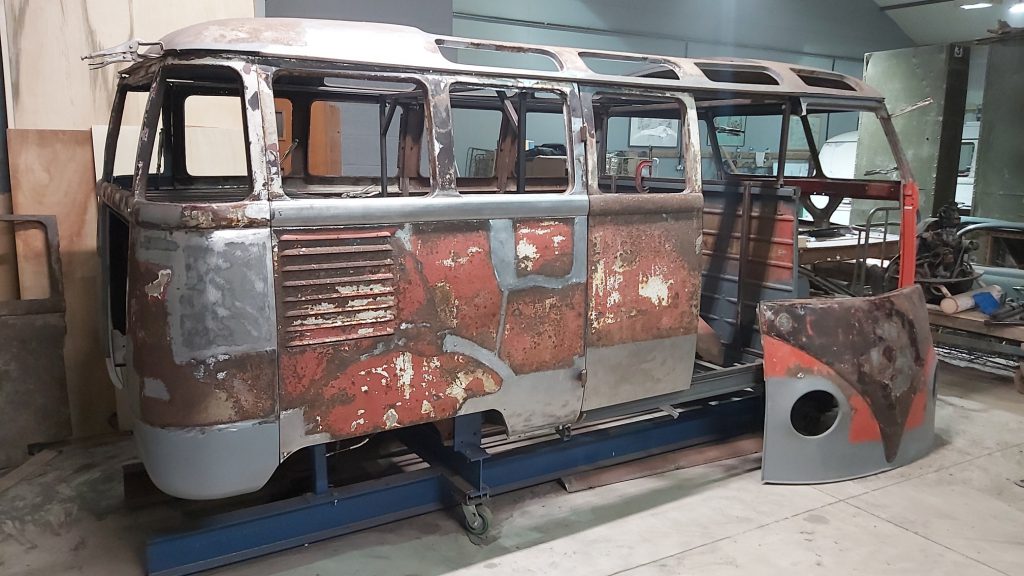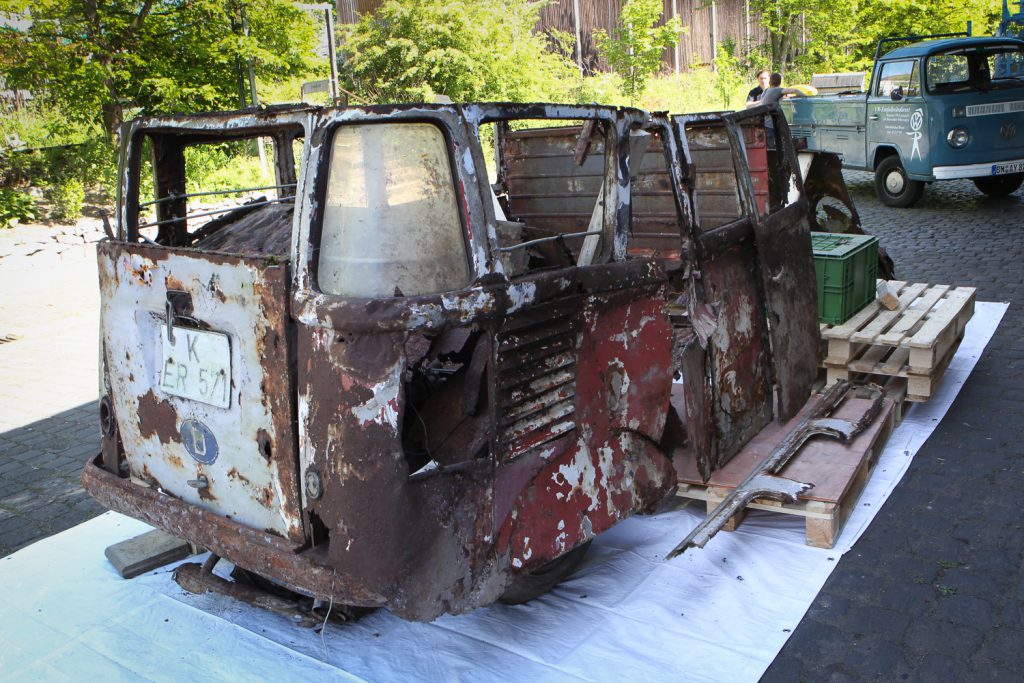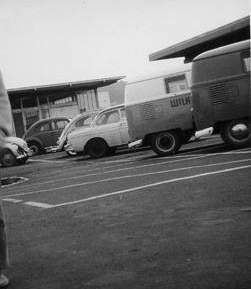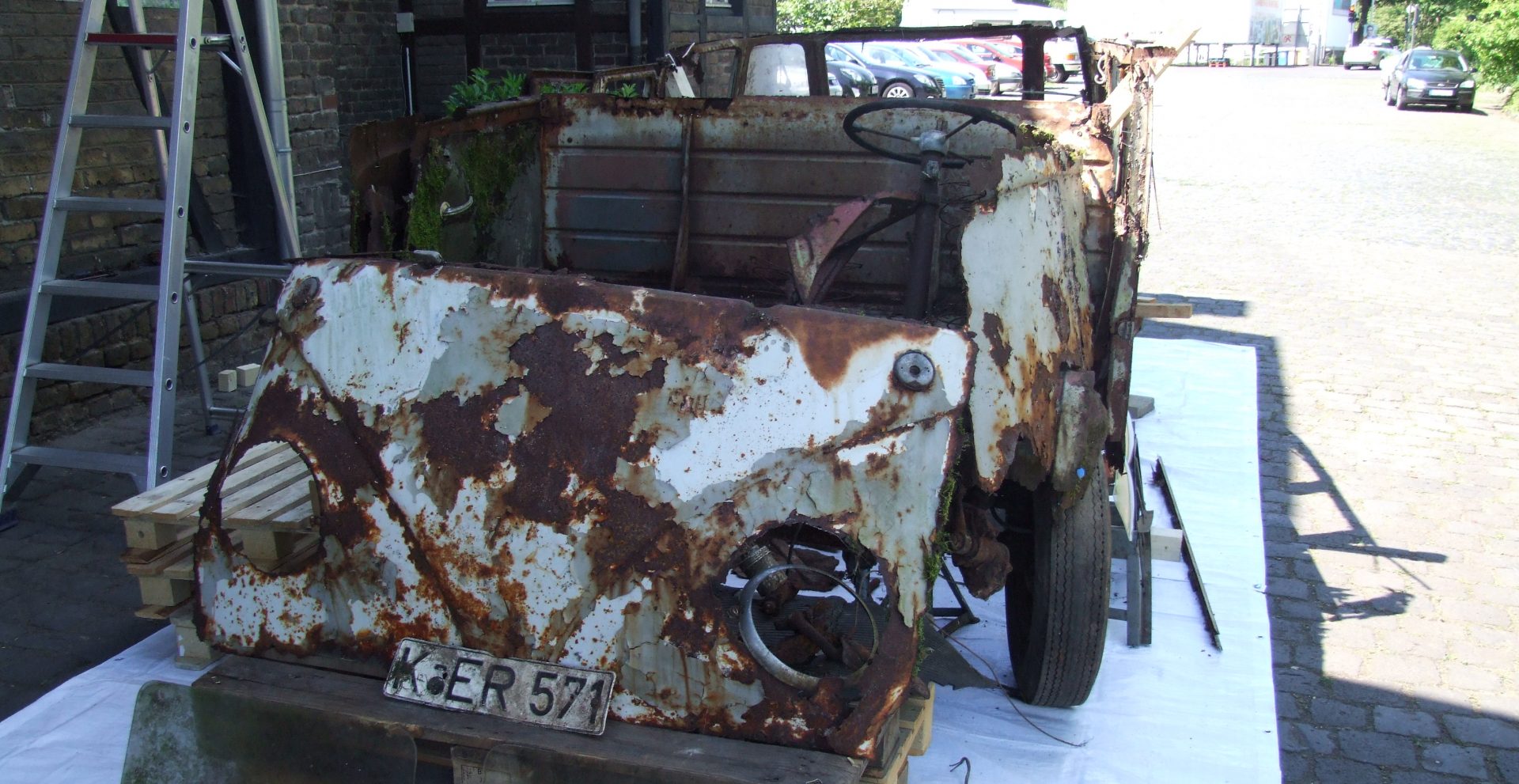Dear VW-friends,
I just received a new picture from Mark showing another chapter of his amazing work. After restoring the lower part of the short side panel he now completed the short side with the swag line, the window section and the hinge pillar. He also restored the rear cargo door plus the right rear corner. He fitted the panels into the Samba ́s body and welded them together with the already restored roof. One picture tells the whole story:

To appreciate Mark ́s work in the right way, you got to see the same section in “raw” condition back in 2017:

Isn ́t that just unreal, how much of the original substance he saved? Even more unbelievable is the fact that all the brown color around the windows is ORIGINAL paint, that Mark brought back to daylight by extremely carefully removing several layers of respray….
While looking at the “before”-picture, there was this old question in my head regarding the huge cut-out hole in the rear right corner. WHY would you cut a big hole into the body of Splitty Bus just at this certain spot? If it would be on the other side the answer would be easy: to have a brutal, but easy access to the gas tank! But what sense does it make on the right side? If you cut a hole here, the only thing you get access to is the battery. What reason could you imagine for a permanent need to reach the battery? Last week, when I saw a service car of VW Fleischhauer here in Bonn, helping a broke down car in the first snow, I found the answer.
Let me tell you a story from my youth. In 1986, I purchased my first Beetle, a ́58 model. I wanted an “old” Beetle since my mother sold her ́66 Beetle in 1974. I was five years old and very angry at my Mom. I liked the Beetle very much and I told Mom: “When I grow up, I will buy an old Beetle!” She answered: “By the time you are grown up, there won ́t be anymore Beetles!” People really thought this way in 1974! The first Rabbits hit the VW showrooms and the Beetle was nothing but a car of the past. Remember, in the 70s, cars reached an average age of only 13 years, not more! Anyway, since this one day back in 1974, my plan was to purchase a really old Beetle as soon as possible and did so when I was 17.
The old lady from which I bought the car totally ripped me of. The ́58 was in terrible condition, but –hey!- it was a ́58 and it still had its semaphores! Could that be a bad deal? It could, believe me! I was able to fix some of the ´58 ́s problems, but rebuilding the link- and king pins was way above my level. So I ended up at VW Fleischhauer in Bonn and asked for help. Sure, the estimated cost of the repair was far out of my budget, but the friendly serviceman felt pity for me and he offered the repair in exchange for two weeks helping him in the workshop. Sounds hard to believe, but that’s the way it went. Anything was possible in the 80s…
So, I spent two weeks of my summer holydays in the VW Fleischhauer Bonn workshop and I learned A LOT. In fact, it was the beginning of my career. The Bonn branch of Fleischhauer was a huge area back in these days, around four times larger than it is today. I searched the net upside down for a picture to give you an impression of its size, but all I could find was this poor result:

Anyway, the yard was so big, the Fleischhauer employees had a company car just to drive around in the yard, transporting spare parts from one hall to the other. This car was a black 1960 ragtop Beetle, a poor car, no TÜV, no license, no interior but the driver ́s seat. They even had a trailer hook mounted to pull a little cage behind the Bug to transport even more parts. You have to keep in mind, it was 1987 and a ́60 ragtop Beetle was a car of close to zero value, just the same as my ́58 was.
Later, when Fleischhauer Bonn moved to a new and much, much smaller location, there was no need for an internal transport car anymore. I saved the little ́60 ragtop from being scraped and he is still alive today.
Now, let me get to the point. The yard of Fleischhauer in Cologne was as big as the Bonn branch. Walter Franz, the CEO of Fleischhauer (read about Walter Franz here), used to “think big” and so he planned both branches pretty generously. Due to the Wolfsburg records, the Samba was delivered as a demonstration car to the Cologne branch. Up until now, we have NO CLUE what happened to the car after its short career as a demonstration car. There are no pictures, no traces, nothing but the Cologne license plates, which were still with the Samba when it was found in the Eifel. I am now searching since three years and by now, I have a quite impressive collection of pictures showing early BD Sambas, even a lot of BD Sambas showing Cologne license plates, but not a single picture of my Samba dated to later than November 1951. Coincidence? I don ́t believe so anymore.
What if Fleischhauer never sold the Samba to release him into a civil life, so somebody could remember the Bus and made some pictures? The Cologne license plates suggest, that at least, the Samba never left Cologne. Plus, the license “K-ER 571” indicates that the car was registered in the center of Cologne, “ER” stands for “inner city”. Well, the Fleischhauer branch was in the center of Cologne!
What if Fleischhauer used the Samba as a service car after being a demonstration car? During the body work, Mark found the holes for the Samba trim screws being welded shut at some point in the past. Who would do that voluntarily but somebody who wants to convert a luxury car into an unadorned van? Hard to believe, that a private person would have purchased a Samba for commercial reasons instead of a much cheaper panel van.
What if, at the end of its service car career, the samba exhausted its first life as an internal “allrounder” in the huge Cologne Fleischhauer yard, just in the same way as they had an internal little helper in the Bonn branch? At this point, the huge hole in the rear right corner begins to make sense: the Samba wasn ́t on the road anymore, but still in internal Fleischhauer use as a helper for any purpose, also jump starting. Fleischhauer always had and still has a big “used cars sale”, jump starting is daily business if you have a large number of second hand cars for sale! The mystery hole made jump starting pretty quick and easy.
What do you think about my theory? To weird or a realistic scenario? Let me know. Friendly comments welcome!
best regards from Bonn
Florian
Hits: 0

6 thoughts on “The Mystery Hole”
Hi Florian, Ich folge Deinem Blog mit wachsendem Interesse und finde das Projekt sehr spannend.
Deine Theorie einer Nutzung als Service-Car würde eventuell auch das Umlackieren erklären – war der Samba dann eventuell in Firmenfarben (falls es sowas gab… ) und evt. mit einer Werbung bzw. einer Firmen-Aufschrift versehen? Könnte mir vorstellen, dass solch eine Aufschrift durch die lange Abstellzeit im Freien einfach komplett verblasst ist oder abgewaschen wurde. Bin da kein Experte, ist nur mal ein Gedanke…
Weiterhin viel Spaß und Erfolg mit der Restauration!
Viele Grüße von der Ostsee!
Jens
Hallo Jens,
ja, den Gedanken mit der Werbeaufschrift hatte ich auch schon. Wir haben auch sehr intensiv danach gesucht, aber leider nichts gefunden.
schönen Gruß aus Bonn
Florian
I can not imagine that.
fleischhauer was a model company in the region.
Such a service vehicle is possible, but the excerpt would certainly have been made by trainees in the workshop. even if it had only been a provisional. the master would certainly have expected something better. With a service flap, for example. . are there any remains of small hinges? I think it was used as a power generator somewhere in the allotment garden. my opinion 🙂
Maarten
Point.
Yes, the master wouldn´t have accept such a brutal solution, especially not in the ´60s.
In fact your theory rg a later use of the Samba in the allotment Eifel garden sounds more realistic now while I remember that we found in the Samba´s gravejard garden the remains of minimum six other cars (another later Splitty, an Oval, a Renault, a Opel, a Ford etc), so fore sure in this place happened something clearly car related, maybe an illegal junkyard or something similar. Possible they used the Samba as a “servicemobile” there too and made the brutal cut back then.
Servus Florian, ich denke deine Theorie könnte gut möglich sein….. und wie zeit gekommen ist hat in dann ein Mitarbeiter mitgenommen, könnte ja sein.
Auf alle Fälle finde ich deine Restauration immer noch einzigartig und wie Mark das macht…. echt Super weiter so.
bin schon auf eine Neue Story gespannt
Gruss Andi aus Bayern
Hallo Andi,
ja, ich halte das inzwischen auch für eine wahrscheinliche Option, daß ein Fleischhauermitarbeiter ihn mit in die Eifel genommen hat, genau so wie ich den 60er Faltdach-Käfer aus der Bonner Fleischhauer-Filiale mitgenommen hab, als der da zur Verschrottung anstand. Zugelassen war der Samba in der Eifel ja nicht, er trug ja noch die entsiegelten Kölner Kennzeichen. Er ist wahrscheinlich lange bevor er in der Eifel seine vorerst letzte Ruhe fand abgemeldet worden -genau so wie der 60er FD in Bonn. Der ist ja auch jahrelang abgemeldet über das Bonner Fleischhauer-Gelände gedüst.
Die nächste Blog-Story dauert noch etwas, ich bin gerade an zwei anderen Projekten dran, die werden aber beide Mitte Februar abgeschlossen sein, dann schreib ich hier weiter.
Gruß vom Rhein
Florian